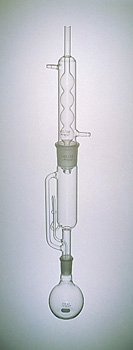2.2.3 Soil/Sediment Samples
Soil and sediment samples present considerable difficulties in sample preparation since the analytes must be extracted and transferred to a liquid phase before introduction into the GC. Early techniques focused on simply washing the air-dried solid matrix with organic solvent but these methods proved to yield low extraction efficiencies (analyte recoveries were considerably less than 100 percent). The gold standard for the extraction of analytes from soil and sediment matrices is the Soxhlet extraction technique. The Soxhlet is a glass distillation setup that repeatedly passes pure solvent through the soil/sediment matrix over a period of 24 to 48 hours. After this time, the solvent is collected and the volume is reduced and analyzed by GC. Laboratory studies have recovered approximately 100 percent of analytes with this method but Soxhlet glassware is expensive (each setup costs at least $300), it uses expensive organic solvents (approximately $150 per four liters), and is very labor and time intensive. Alternatives to the Soxhlet technique include relatively rapid sonication procedures and automated heated solvent extraction systems.
 |
 |
Figure 2.4 Soxhlet Extraction Glassware. Reprinted with permission from VWR Scientific Products International, Chemglass Life Sciences, and Corning.
| Frank's Homepage |
©Dunnivant & Ginsbach, 2008